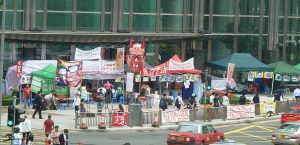On March 28, 2013, 500 dock workers in Hong Kong Kwai Chung Containers Port, one of Asia’s busiest ports, went on a strike for 40 days. It was the largest strike in the city since the 1960s.
The workers marched with their heads held high, the first such protest on site at the port. They demanded a pay raise and sought improved working conditions including lunch and toilet breaks. They gained unprecedented support in Hong Kong, as well as their colleagues worldwide from Australia to South Korea, the Netherlands and the United States.
Yet, like many strike actions, it was an asymmetric fight at the start. The dockers were facing the richest man in Asia, Lee Ka-shing.
Before March 2013, several dock workers had tried to initiate strikes multiple times. They were bound to fail, however, at a port where information was heavily censored and outspoken dockers risked retaliation or even dismissal.
The dockers didn’t give up, however. Instead, they stepped up their efforts to consolidate their organizing work and engage in workers on the ground. They recruited student volunteers to assist outreaching to grassroot workers at least twice a week and identified potential workers to join the strike.
Public engagement was critical in turning the tide in this asymmetrical fight. The dockers’ strike shed a light on corporate monopoly, a deep-rooted problem that resonated with the majority of the public and effectively generated widespread popular support, with nearly 9 million Hong Kong dollars in public contributions to their strike fund.
The 40-day strike successfully mobilized people beyond the port and engaged people from different sectors and locations to join forces: from students and activists hosting events to raise awareness of the strike, to citizens boycotting the Lee Ka-shing owned businesses, and solidarity actions from overseas trade unions. Their mode of mobilization also attracted interest from academics and became a case study for Social Movement Unionism.
Fast forward to Hong Kong today. The civil society, including trade unions, is confronting a sweeping wave of repression. Since the imposition of the National Security Law, dozens of trade unions have been forced to disband, including the Hong Kong Confederation of Trade Unions (HKCTU), the city’s second largest trade union confederation, which played an important role in pushing the dockers’ strike.
Lee Cheuk-yan, a former HKCTU leader who led hundreds of workers in the 2013 march at the port, has been imprisoned for almost two years for participating in peaceful protests. He is also facing another subversion charge under the Hong Kong National Security Law, with a maximum sentence of 10 years in jail.
Hong Kong’s civil society is under attack. Its civic space sank to the worst rating, from “repressed” to “closed,” in the latest report by CIVICUS Monitor. Hong Kong is now ranked alongside other closed civil societies such as Afghanistan, China, Laos, Myanmar, North Korea, and Vietnam.
Though a decade has passed, I can still recall vividly that the dockers told me what inspired them to join the strike. It was not the eloquent words of the strike organizers, but the 36-days bar-benders strike in 2007.
Soon after the dockers’ strike in Hong Kong ended, hundreds of dockers in Shenzhen employed by the same corporation initiated another walkout in September 2013.
People who are oppressed will learn from one another. They pass on the memory of struggle. One labor struggle will set off another in a different time and place.
Despite the authorities’ relentless all-out crackdown, they can hardly wipe out the network and dynamics of the Hong Kong civil society overnight. On the contrary, new forms of resistance are emerging in Hong Kong.
Foodpanda riders, for example, have successfully gone on strike three times since September 2021. Without the leading of a trade union, they were still able to successfully mobilize themselves through social media, with the help of some labor activists. The spirit of resistance lives on in the hearts of the people in Hong Kong, and they are exploring creative and innovative ways to defend what little civic space remains.
It’s not hard to trace similar patterns in the democracy movement in Hong Kong. In 2003, half a million Hong Kongers took to the street to protest against Article 23. In 2014, we joined the Umbrella Movement and occupied the heart of Hong Kong’s financial hub for 79 days. In 2019, 2 million Hong Kongers regrouped on the street to declare their devotion to freedom and democracy.
Every episode of our struggle will be etched indelibly into our collective memory. It will encourage and inspire others who follow and become a source of courage and strength.

































